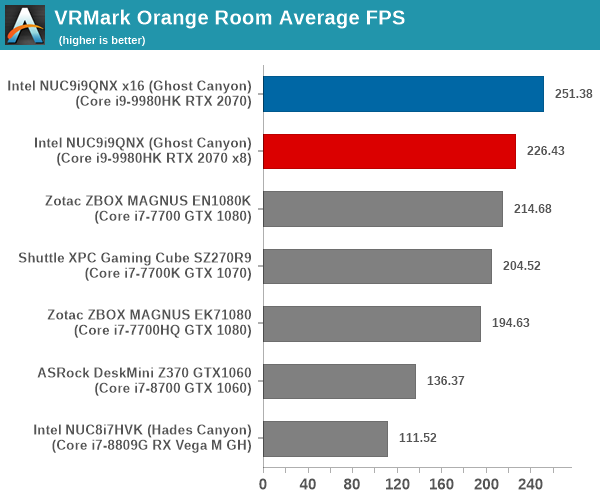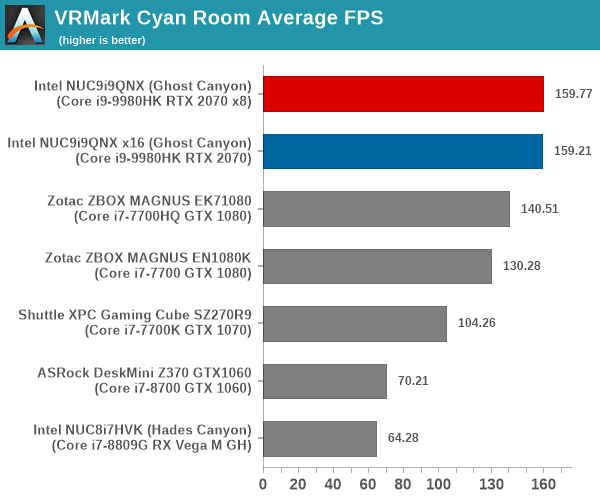Intel Ghost Canyon NUC9i9QNX Review: NUC 9 Extreme Realizes the SFF Dream
by Ganesh T S on April 16, 2020 8:05 AM ESTUL Benchmarks - PCMark, 3DMark, and VRMark
This section deals with a selection of the UL Futuremark benchmarks - PCMark 10, PCMark 8, and 3DMark. While the first two evaluate the system as a whole, 3DMark focuses on the graphics capabilities.
PCMark 10
UL's PCMark 10 evaluates computing systems for various usage scenarios (generic / essential tasks such as web browsing and starting up applications, productivity tasks such as editing spreadsheets and documents, gaming, and digital content creation). We benchmarked select PCs with the PCMark 10 Extended profile and recorded the scores for various scenarios. These scores are heavily influenced by the CPU and GPU in the system, though the RAM and storage device also play a part. The power plan was set to Balanced for all the PCs while processing the PCMark 10 benchmark.





PCMark 8
We continue to present PCMark 8 benchmark results (as those have more comparison points) while our PCMark 10 scores database for systems grows in size. PCMark 8 provides various usage scenarios (home, creative and work) and offers ways to benchmark both baseline (CPU-only) as well as OpenCL accelerated (CPU + GPU) performance. We benchmarked select PCs for the OpenCL accelerated performance in all three usage scenarios.



UL's 3DMark comes with a diverse set of graphics workloads that target different Direct3D feature levels. Correspondingly, the rendering resolutions are also different. The VRMark benchmark targets virtual reality specifically. Its workloads are termed as 'rooms', with each one being a piece of VR content designed to require a specific level of VR performance. We used 3DMark 2.4.4264 and VRMark 1.2.1701 to get an idea of the graphics capabilities of various systems. In this section, we take a look at the performance of the Intel NUC9i9QNX (Ghost Canyon) on a comparative basis across the different workloads.
3DMark Ice Storm
This workload has three levels of varying complexity - the vanilla Ice Storm, Ice Storm Unlimited, and Ice Storm Extreme. It is a cross-platform benchmark (which means that the scores can be compared across different tablets and smartphones as well). All three use DirectX 11 (feature level 9) / OpenGL ES 2.0. While the Extreme renders at 1920 x 1080, the other two render at 1280 x 720. The graphs below present the various Ice Storm worloads' numbers for different systems that we have evaluated.
| UL 3DMark - Ice Storm Workloads | |||

3DMark Cloud Gate
The Cloud Gate workload is meant for notebooks and typical home PCs, and uses DirectX 11 (feature level 10) to render frames at 1280 x 720. The graph below presents the overall score for the workload across all the systems that are being compared.

3DMark Sky Diver
The Sky Diver workload is meant for gaming notebooks and mid-range PCs, and uses DirectX 11 (feature level 11) to render frames at 1920 x 1080. The graph below presents the overall score for the workload across all the systems that are being compared.

3DMark Fire Strike Extreme
The Fire Strike benchmark has three workloads. The base version is meant for high-performance gaming PCs. Similar to Sky Diver, it uses DirectX 11 (feature level 11) to render frames at 1920 x 1080. The Ultra version targets 4K gaming system, and renders at 3840 x 2160. However, we only deal with the Extreme version in our benchmarking - It renders at 2560 x 1440, and targets multi-GPU systems and overclocked PCs. The graph below presents the overall score for the Fire Strike Extreme benchmark across all the systems that are being compared.

3DMark Time Spy
The Time Spy workload has two levels with different complexities. Both use DirectX 12 (feature level 11). However, the plain version targets high-performance gaming PCs with a 2560 x 1440 render resolution, while the Extreme version renders at 3840 x 2160 resolution. The graphs below present both numbers for all the systems that are being compared in this review.
| UL 3DMark - Time Spy Workloads | |||

The VRMark Professional Edition comes with three rooms. Each room can be run either in desktop or HMD mode, with varying minimum requirements for the same workload. The benchmark results include the average FPS achieved, and a score based on the FPS. A pass or fail indicator is also provided based on whether the average FPS exceeds the required FPS. In this section, we take a look at the performance of the Intel NUC9i9QNX (Ghost Canyon) on a comparative basis across the three workloads in desktop mode.
VRMark Orange Room
The Orange Room is meant to test the effectiveness of a system for handling the requirements of the HTC Vive and the Oculus Rift. The recommended hardware for both VR HMDs should be able to easily achieve the desired target FPS (88.9 fps). However, in the desktop mode, the target performance is 109 fps without any frame drops. Systems benching with an average FPS lesser than that are deemed to have failed the VRMark Orange Room benchmark. The graphs below present the average FPS and score for the different systems being considered today.
| UL VRMark - Orange Room | |||

VRMark Cyan Room
The Cyan Room sits between the Orange and Blue rooms in complexity. It is a DirectX 12 benchmark. Similar to the Orange room, the target metrics are 88.9 fps on HMDs and 109 fps on the desktop monitor. The graphs below present the average FPS and score for the different systems being considered today.
| UL VRMark - Cyan Room | |||

VRMark Blue Room
The Blue Room is the most demanding of the three workloads. At the time of introduction of VRMark in October 2016, no publicly available system running as sold was able to pass the test. The Ghost Canyon NUC configuration with the RTX 2070 performs better than any previously benchmarked system, but it still doesn't meet the requirements to pass the VRMark Blue Room test.
The performance of a system in this benchmark is an indicator of its VR-readiness for future generation of HMDs. Similar to the other workloads, the passing performance metrics are 88.9 fps on HMDs and 109 fps on desktop monitors. The complexity of the workload is due to the higher resolution (5012 x 2880) and additional geometry making it necessary to increase the number of Direct3D API calls. The graphs below present the average FPS and score for the different systems being considered today.
| UL VRMark - Blue Room | |||











109 Comments
View All Comments
timecop1818 - Thursday, April 16, 2020 - link
Really bad selection of pictures. Did you not actually have a unit with you when reviewing? There's no external shots, there's no pics of the board/GPU connected together, there's no pics of rear backplane with ports/whatever, basically no useful info. I clicked through the gallery and I have no idea how big this thing is, or how the GPU fits into the picture, or anything else. Even "setup notes" page shows nothing useful.DanNeely - Thursday, April 16, 2020 - link
The chassis gallery on the 1st page shows the fully assembled system with the rear IO ports visible and gives a decent visual idea of how big the system is.timecop1818 - Thursday, April 16, 2020 - link
Oh hey, I see the stuff now. There's separate galleries throughout the article, for some reason I thought there was only one per page, and the 1st page only showed disassembled cpu module so I thought that was it. Thanks for pointing it out.FireSnake - Thursday, April 16, 2020 - link
Based on this:https://www.notebookcheck.net/AnandTech-editor-rep...
they are not getting any money from me!
For a loooong looong time (those includd too).
bug77 - Thursday, April 16, 2020 - link
It's a good thing you don't get hung up on details like proof and stuff. Guilty until proven innocent, eh? (And yes, I know history doesn't work in their favor.)DigitalFreak - Thursday, April 16, 2020 - link
Ian doesn't seem like the person to throw around baseless accusations.ganeshts - Thursday, April 16, 2020 - link
The tweet has been misinterpreted and now taken a completely unintended shape of its own. Ian plans to clarify the usage of the word 'incentive' in the context in an upcoming video / post.FWIW, if anyone believe AMD doesn't offer incentives to its partners (of a type similar to what Intel does, and what is completely legal), then the person has no idea of how the technology industry / silicon vendors operate.
If anyone thinks the reason for lack of high-performance AMD-based (read, Renoir) 'NUC's is Intel, then I have a bridge to sell. No one is preventing AMD from creating a reference design for a Renoir-based 4x4 board or innovate with Compute Element-like products. OEMs can take the plunge only if the silicon vendors offer them a proof of concept. If a Renoir NUC reference design exists, but OEMs still don't pick it up to offer them in the market, that would be worthy of deeper investigation (that could still throw up legitimate reasons).
Namisecond - Friday, April 17, 2020 - link
Even when reference designs exist, availability of parts can come into play, or even OEM disinterest.quadrivial - Friday, April 17, 2020 - link
AMD has reference designs and an entire set of embedded Zen 1 chips made explicitly for that purpose. Udoo Bolt was kickstarted by a fairly small company. If they could do it, why not bigger companies?arashi - Saturday, April 18, 2020 - link
You must understand that Intel PR and legal has been in touch.